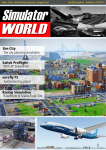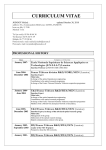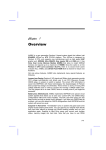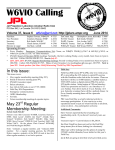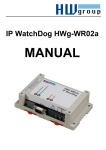Download April1995 W6VIO Calling
Transcript
W6VIO Calling Jet Propulsion Laboratory Amateur Radio Club 4800 Oak Grove Drive, Pasadena, CA 91109-8099 Volume 24 Issue 3 President: Vice President: Secretary: 7525 Treasurer: Director at Large: April 1995 Merv MacMedan, N6NO, 4-7004 Jay Holladay, W6EJJ, 4-7758 George Morris, W6ABW, 4-0035 Emer. Comm. Mgr: Walt Mushagain, K6DNS, 4-3036 W6VIO Trustee : Jan Tarsala, WB6VRN, 4-4564 WB6IEA Trustee: Walt Diem, WA6PEA, 818-248- Jim Marr, AA6QI, 3-1528 Bob Dengler, NO6B, 4-9620 W6VIO Calling Editor; WB6TZS Trustee: Bill Wood, WB6FXJ, 619-256-5529 Meeting Notice By Jay Holladay, W6EJJ T he next regular JPL Amateur Radio Club membership meeting will be held on Wednesday, April 12, at noon in 238-543. Note: This meeting room is reserved for the second Wednesday of each month for the rest of the year. Club Board of Directors meetings are held on the fourth Wednesday of each month in 301-227. Everyone is welcome at both meetings; bring your lunch. Our April meeting will feature a program on JPL ARC activities in the area of digital communications. Greg La Borde and Gerry Walsh will tell us about current capabilities, such as the packet radio BBS and the JPL ARC home page, and plans for the future. Please join us at Noon on Wednesday, April 12 in Bldg. 238, Room 543. Other Upcoming Events: April 15; finish W6VIO shack hardline refurbishment May 6; continued cleanup of the W6VIO operations trailer. Contact Bob Polansky, N6ET. March Club Meetings By George Morris, W6ABW T he regular membership meeting was held in 238-543 at noon on March 8, 1995. The meeting was called to order by Secretary George Morris, W6ABW. The first guest speaker, John Callas, of the Mars Global Surveyor project presented their plans to involve the amateur radio community in the testing of radio relay equipment after launch late in 1996. (See the detailed article on MGS Relay Checkout on page 4 in this newsletter.) The second speaker, Mike Stewart, N6PLM, presented an overview of the plans to allow the use of DSS-12, after it is decommissioned next year, for radio astronomy by the Apple Permission to copy is granted provided that credit is given to “W6VIO Calling.” Valley Science and Technology Center (AVSTC). This is part of a JPL educational outreach program to involve students in science. The AVSTC is interested in promoting science, math and technology to secondary students in the High Desert. What is being proposed is to convert DSS-12, a 34-meter antenna at Goldstone scheduled to be decommissioned early next year, into a remotely operated student radio telescope. Mike feels that there are opportunities for the radio club to assist technically in this effort. The one thing this club has is a broad breadth of technical talent that can make important contributions to this effort. Benefits to the club include the possible use of the antenna for EME experiments when it is not being used for radio astronomy. The regular Board of Director’s meeting was held in Room 301-227, on March 22, 1995. A quorum was present. The meeting was called to order by President Merv MacMedan. Last month’s minutes were approved with one deletion. Treasurer Jim Marr gave his report. Merv MacMedan appointed Greg La Borde Chairman of the Packet Radio Committee. A proposal for the Apollo 11 certificates will be submitted to ERC. ERC will coordinate the printing of “W6VIO Calling,” starting with the May issue. Editor Bill Wood will provide Mark Banuelos with an electronic version to use for the printing. George Morris will make an emergency communications presentation to two visiting amateur radio clubs on July 28. Work parties will be held at the W6VIO shack every three weeks starting April 1 until everything is cleaned up and organized. Nevil Eyre, VK1NE, of the Canberra DSCC was accepted as an overseas member by a vote of the Board. Bill Wood was authorized to exchange newsletters with other clubs. Possible new frequencies for WB6IEA 220 MHz repeater were discussed. Newsletter Deadline: April 28 for the May issue. Your articles, ads, photos, diagrams, letters to the editor, or technical material should be submitted to the Editor at the return address shown on the last page of this newsletter. 2 W6VIO Calling Field Day, 1995 By Bob Polansky, N6ET and Jay Holladay, W6EJJ F ield Day 1995 is fast approaching! This year’s event will be held June 24 and 25. We will again team up with the Caltech Radio Club and make another assault on the USA #1 position in Class 3A. Our effort last year was only a few more than 100 QSO’s short of the number 1 spot. We know we can win! In the spirit of sharing the glory, we will be using W6UE as our Field Day callsign this year. We have already applied for our permit for Mt. Gleason, and other planning is underway. The JPL ARC meeting on May 10 will be devoted to a program on plans for this Field Day and our past accomplishments. Plan on joining us on Mt. Gleason this year, for a unique wilderness experience, lots of good food, and the fun of a joint assault on the #1 position. You’ll have a ball! Field Day, 1971 By Mike Frantz, KM6QZ April, 1995 The author concluded his report by saying how what a tremendous cleanup job the crew did after the event, and goes on to say that next year “you can rest assured that all contingencies will be covered to stay on the air for 24 straight hours— or will they??” DX News By Bob Polansky, N6ET C onditions have sure been strange this last month. The DX contests have been both spectacular and boring depending on the day and the hour that one participated. I personally observed conditions changing radically over a 5-minute period. In spite of these problems, my wire dipoles and 100 watts (of non-effective radiated power) gave me lots of enjoyment in the CQ phone contests. The DX Bulletin shows much planned activity over the next month. Hope you find a few of these: CAMEROON - TJ1JB hangs out on 20 CW from 1700 to 2000Z. No frequencies published on this one. DODECANESE - SV5TH operates from 1400Z around 14007 kHz. This may be a bit early for the West Coast, but you may have a chance if he stays around for a while. he headline in the July 1971 edition of W6VIO CALLING read W6VIO CONQUERS (?) FIELD DAY. The author of the article called the field day experience “a comedy of errors.” But it did not seem funny to those involved at the time. T FRANZ JOSEF LAND - We have it on good authority that the Russian Base in FJL may be closed in the next few months. R1FJL and RX1OX/FJL are still active. Work them quickly if you need FJL. I heard R1FJL on 17 meters a week ago, but I can’t remember if it was on SSB or CW. The site for Field Day that year was Mt. Wilson, one hundred yards from the 100 inch Hale telescope. The participants located the 2-meter beam on top of the Solar Telescope tower. This gave the VHF’ers full line of sight from San Diego to Santa Barbara. However the smog was so bad the participants could not see Altadena below. MALDIVES - Look for 8Q7AI, the requested callsign of DL1IAI who plans 80 through 10 meter activity from 12 - 27 April. If propagation cooperates, this will be well worth trying to contact. Problems started almost right away. The generator developed problems and quit. A replacement generator was found that was rated at 500 watts, while all the rigs were demanding close to 700. The line supply voltage quickly settled down to what the author described as “a soggy 75, giving birth to a multitude of chirping birdies atop Mt. Wilson.” About 4 AM another problem occurred, a very serious problem. While they crew brought along plenty of gas, they forgot to bring oil. The over-worked generator ran out of oil, and very shortly thereafter seized up. Stan Brokyl (then K6YYQ) saved the day by fixing the generator with “liberal doses of penetrant and expletives.” One would think that the crew’s troubles would be over. Well, not quite. Another radio, working off a 12-volt battery, had problems. After running for about four hours, it was discovered that the switch between the generator and batter had never been closed. “The battery plates were not the only things bent slightly out of shape by that time.” The crew made 709 contacts for a total of about 1800 points. This put them somewhere in the middle of the pack. “...really not too bad for the first time out.” MAURITANIA - 5T0AS is on the air now through April 20th. NEPAL - 9N1MWU plans to be active from 26 April through 10 May. No frequencies given. SAO TOME - S92YL and S92SS have both been workable on 20, 17, and 15 meter CW and SSB from 1900 to 2100Z. They are loud on all bands, readily workable, and quick QSL’ers. Look for the pile-up. One CW spot was at 14005 kHz from 1900Z, another on 18145 kHz. SVALBARD - JW0I is very popular on 7008 kHz around 0600Z. He’s also got a fine signal. ZAIRE - Both 9Q5TT and 9Q5MRC are quite active. I’ve heard them on both 20 and 17 meter CW. 9Q5TT leaves Zaire at the end of April. Large pile-ups, light signals. Good luck! That’s enough DX for one article. Tune up your earballs and have at it! Did You Fill Out Last Month’s Survey? The club needs to know what you think about where the JPL ARC should be going. If you did not, go back to the March issue, fill out the survey and send it in. 3 W6VIO Calling The 911 System Written by Dave Buhler, WB6ZGF and adapted by Walt Diem, WA6PEA W e in amateur radio are in a unique position to be able to communicate over long distances almost at will. Because of this capability, we need to understand how to use the emergency systems available to us as efficiently as possible. To more effectively utilize the 911 emergency telephone number capability, it is useful to know a little about how the system works and special conditions that apply when we use it via Amateur Radio. How Does It Work? When you dial 911, your call is routed over special trunks to a 911 Tandem office that contains unique switching equipment with access to a large database. The calling phone number is one of the things sent to this office to determine from the database to which Public Service Answer Point (PSAP) your call should be directed. For example, if you live in Altadena, but have a Pasadena exchange telephone number, you want your call to go to the PSAP at the Altadena Sheriff’s station, rather than to the PSAP at the Pasadena PD. After determining the proper routing, your call is sent to the appropriate PSAP, which extracts from the database the address from which the call was made and displays the address of the calling phone number on the dedicated 911 CRT screen at the communications console of the PSAP. 911 and Amateur Radio The Autopatch User’s Manual lists the code for fast dialing of 911 via the patch. Note that it also lists a separate number for fast dialing directly to the CHP. Whenever you access the public switched (telephone) network via your radio, you need to remember that the dial tone you receive comes from a line that is dedicated to a particular phone number and address. When you call via a repeater, the call is routed to the PSAP that services the area where the repeater is located. The PSAP for the Club’s WB6IEA autopatch repeater is at the Crescenta Valley Sheriff’s station. When you dial 911 on an autopatch, the address on the CRT display will be the “service address” of that phone number and the PSAP operator will not be expecting a mobile or portable radio transmission. For that reason it’s very important that you immediately explain that you are an Amateur Radio operator on a mobile radio and not at the address on the screen. This will defuse a potentially confusing conversation that can delay an emergency response. It will also prevent dispatching emergency vehicles to the repeater site. When you call 911 via the Club’s WB6IEA autopatch repeater, the comments field on the CRT display says “Amateur Radio Repeater, Verify address” to reinforce your statement that you are not at the address displayed on the screen. One of the biggest problems with reporting accidents or other emergencies on an autopatch is that the PSAP may not be in the same area as the emergency. If that is the case, the PSAP operator will either “patch” you through or give you the phone April, 1995 number of the proper agency. In either case, understand that this will take extra time, especially if the PSAP operator is unfamiliar with the area that you are in. Be sure the next PSAP operator also understands you are on a mobile radio. Reporting an emergency from a mobile to a base station generates the same problems described above. The base operator first needs to explain to the PSAP that he has a report of an emergency from an amateur radio operator at another location, then make the report. The base operator has a dilemma, though. If the mobile is not in the local area, should he call 911 anyway, or try to find the right number in the phone book? This is a judgment call on the part of the base station and there is no “one size fits all” answer. The operator must use his or her experience and best decision-making ability. It's a good idea, though, to keep a list of local PD and Fire phone numbers near your operating position, just in case. Many Amateurs may also have a cellular telephone (celphone) in their cars or a celphone portable. The designated PSAP for 911 calls from a celphone is the California Highway Patrol, since it is assumed most emergency calls from a vehicle will involve traffic accidents. Making the Report First, STAY CALM! Be prepared to give the exact nature of the emergency (traffic accident, vehicle fire, etc.) whether or not there are any injuries (check before calling!) and the exact location (address or, if an intersection, both cross streets). The PSAP operator may ask some additional questions. He or she is not wasting time, but needs to prioritize and clarify things. Emergency response may already be enroute even as they are talking to you, so please be patient. When Do I? When Don't I? Recently, you may have noticed some items in the news regarding the misuse of the 911 emergency system. After a concerted effort to make everyone aware of 911, a problem has developed from people using it for everything from a cat up a tree to a hangnail. Once again, there is no “one size fits all” answer, but there are a couple of rules of thumb: 1. Is there a threat to human life or has there been human injury? 2. Is there a threat of property damage? If the answer to either of these questions is “yes,” then you have a situation in which you should call 911. A lot of time and effort has gone into the creation and implementation of the 911 emergency system. It has saved lives and prevented or limited property damage. It can bring help even if you can't speak for whatever reason. Be aware that if you can’t speak or get disconnected, the PSAP will dispatch emergency equipment to the telephone’s address listed on the 911 screen. This article was originally published in the December 1994 issue of Q5, Downey Amateur Radio Club. 4 W6VIO Calling April, 1995 Tests of the relay uplink will be conducted using an amateur modified DSN 34-meter or 70-meter antenna, or the Stanford University 46-meter antenna. Special permission by radio authorities will be required since 401.5275 MHz is below the authorized amateur band. Initial calculations show a power level of 1100 watts will be required with a ground station antenna gain of 43 dBi. MGS Relay Checkout By Bill Wood, WB6FXJ A t the regular March 8 meeting of the JPL ARC, Dr. John Callas of the Mars Global Surveyor Project presented an opportunity for the amateur radio community to assist in the testing of a key spacecraft component after launch. Dr. Callas outlined plans for the testing of radio relay equipment on the Mars Global Surveyor (MGS) spacecraft shortly after launch in late 1996. Since the relay equipment operates in and near the 420-450 MHz band active participation by radio amateurs is being sought. The MGS project also wishes to involve students as part of an outreach activity. This is a functional test of the spacecraft subsystem and they would like to involve average citizens and people who do not have the opportunity to work with the space program. There may be schools that have equipment that might be able to listen in. A world-wide network could be set up. The relay system, first used on the Mars Observer spacecraft, operates with an uplink of 401.5275 MHz and a downlink of 437.1 MHz. It is designed to communicate with scientific packages on the surface of Mars while MGS is in orbit around the planet. Data collected from the packages will be relayed back to Earth on the spacecraft X-band communication link. The launch of the Mars Global Surveyor is planned for November 3, 1996, with testing of the payload relay equipment to be conducted approximately 30 days later in early December of 1996. While the spacecraft is expected to be about 10 million km from the Earth at the time of the tests, beacon signals should be sufficiently strong to be detected by ground stations using equipment with antenna gains above 20 dBi and system temperatures below 150 degrees Kelvin. An array of four 15-element yagis provides about 21 dBi of gain. Amateurs who have sensitive 432 MHz moonbounce systems, such as Frank Potts’ forty-eight 15-element yagi array shown in this photograph from the cover of the April QST, should be able to receive the signals with plenty of margin. NC1I’s Forty-Eight 15-Element 432 MHz Yagi Array During the testing period the spacecraft is expected to be rotating at a 100 minute per cycle rate to maintain thermal and attitude control. The spin axis is expected to be 30 degrees off the Earth line. That will cause the relay signal to nutate every 100 minutes. However, the antenna gain towards the Earth stays above 0 dB for an appreciable amount of the spin cycle. This characteristic signal variation should allow easy identification of the signal during the test period. Continued on page 5 5 W6VIO Calling JPL wants to invite the amateur community all round the world to participate in listening for this signal. JPL will provide Right Ascension and Declination coordinates for the spacecraft as a function of time, the appropriate Doppler signature, and what the rotational phasing of the spacecraft is, so that observers will know how the antenna position will affect the downlink signal. That would allow people to expect the signal at a certain time. Dr. Callas plans to again work with Dr. Michael Owen, of the St. Lawrence University in Canton, N.Y., on student involvement in the project. Michael has written articles for QST before and is John’s contact with the Algonquin Radio Observatory. They expect to collaborate on a QST article that will explain the relay tests in more detail some time in the next few months. Is It Really Broken? From the February 1995 Kenwood Report T he most unwelcome event that can happen to any ham radio operator is for his or her rig to stop working. We have found that the vast number of failures can be attributed to incorrect operation of the radio, rather than equipment failure. In this article we will deal with some of the simple things you can do to determine if there is really something broken, or if there might be some other cause. We have found that a simple three step procedure will help to discover the problem area. Step 1 Take a little time and read the instruction manual all the way through. You’d be surprised to find how many problems can be solved this way. Let’s look at several examples. Symptom: “My radio cuts in and out of receive. It happens on all bands, and the transmitter is okay.” Cause: The Squelch control on the radio is causing the receiver audio to turn on and off, or the Priority Alert function of your radio is on. Cure: Turn the Squelch control fully counterclockwise, or turn off the Priority Alert. April, 1995 Symptom: “I can’t get the automatic antenna tuner to function properly.” Cause: Not enough power for the tuner to sense forward and reflected power, or the transceiver’s antenna tuner menus are not properly configured. Cure: Adjust the carrier control for an on-scale ALC reading in the CW mode per instructions in the operator’s manual. For the Menus, if your transceiver has them, be sure to check to make sure that any menu items that relate to the auto-tuner have been properly configured. Step 2 Is the station installed properly? Many times we receive calls about symptoms that are caused by inadequate station set-up. Let’s look at a couple of examples to illustrate this point. Symptom: “Every time I key the transceiver, the lights get brighter on the display; or I get ‘bit’ by the exposed metal surfaces on my microphone and radio; or my transmitted signal is distorted, etc.” Cause: The antenna is too close to the transceiver location (less than 40 feet) or poor station grounding. (This is single most frequent cause of transmitter failures or incorrect operation!) Cure: Move the antenna and make sure ail equipment that is attached to the radio is properly grounded. This is especially critical on HF frequencies when using wire type antennas, and for apartment dwellers. If you cannot supply a good short ground, less than a 1/4 wavelength on 10 meters, use a use a counterpoise. (A counterpoise is a 1/4 wavelength piece of wire with one end attached to the ground lug on the radio. The other end of the wire is left free and may be tucked along the wall. It should be cut to a length that corresponds to the center of the band(s) that are giving you trouble.) Symptom: “Every time I key the radio the lights dim, or the frequency display jumps around, or the transmit audio is distorted, or I don’t get full power output.” Cause: Not enough voltage being supplied to the transceiver under load or RF feedback (RFI) is interfering with the operation of the power supply. Cure: Make sure your power supply will supply enough current and voltage for the job. Measure the DC voltage at the power connector on the rig in transmit. The voltage should not drop under load! For RFI problems, wrap the DC cable around a toroid core, or add a 0.01 μf bypass capacitors between the dc line and ground. Step 3 If Step 1 and Step 2 don’t result in a cure for your symptom, give your dealer or the manufacturer’s service center a call. Sometimes discussing the problem with a trained representative will allow you to recognize the problem and save an unneeded trip to the service shop. Sometimes books have errors or omissions and one of their representatives can provide the needed information on the phone, or can send a correction for the manual. 6 W6VIO Calling April, 1995 ARRL News Upcoming VEC Examinations Provided by Jan Tarsala, WB6VRN he following test session information is provided by the ARRL/VEC for the upcoming eight week period. For further information, please call the test session contact person at the telephone number listed. If necessary, you may contact the ARRL/VEC at 203-666-1541 x282 for additional information. Electronic mail may be forwarded to the ARRL/VEC via USENET at “[email protected]” or via MCI Mail to MCI ID: 653-2312 or 215-5052. Amateurs Get 219 MHz ARRL Bulletin 25 T he FCC has released a Report and Order in ET Docket No. 93-40, allocating the 219 to 220 MHz band on a secondary basis to the Amateur Service for point-topoint fixed digital message forwarding systems. The allocation had been requested by the ARRL as partial compensation for the loss of the 220 to 222 MHz band. When the new rules take effect, on a date that has not yet been announced, Technician and higher class amateur licensees will be permitted to use digital emissions of up to 100 kHz bandwidth and no more than 50 watts PEP output. The primary occupant of the band is the Automated Maritime Telecommunications Systems (AMTS). To protect the primary occupant, the ARRL has been designated as the national contact point for all amateur operations in the 219 to 220 MHz band and is responsible for maintaining a database of all amateur operations in the band. All amateur stations must notify the ARRL at least 30 days prior to initiation of operations in the 219 to 220 MHz band. Amateur stations within 50 miles of an AMTS coast station must obtain the written approval of the AMTS licensee prior to operating. Amateur stations within 398 miles of an AMTS coast station must notify the AMTS licensee in writing at least 30 days prior to initiation of operations. The ARRL will assist amateurs in fulfilling these requirements. Amateur stations operating in the 219 to 220 MHz band are not permitted to interfere with, nor are they protected from interference by, primary service operations in and adjacent to the band. The FCC action climaxes almost six years of effort by the ARRL. For additional background see May 1993 QST, page 9. Full details will appear in May 1995 QST. Vanity Call Schedule ARRL Bulletin 21 T he Federal Communications Commission form necessary for applying for an Amateur Radio vanity call sign–Form 610-V–will not be available until after May 1. Amateurs who call the FCC to request the form before then will not have their names recorded and it will be necessary for them to request the form again, when it is available. Applications for amateur vanity call signs will not be accepted until after the forms are available, i.e., until sometime after May 1. The FCC will make a public announcement of the date of opening of the first “gate” for vanity call sign applications. Beginning May 1, 1995, FCC Form 610-V may be requested by calling the FCC Forms Distribution Center at 1-800-4183676. Or, send an SASE to ARRL-VEC anytime, for a form 610-V by return mail as soon as they are available after May 1. Write “Form 610-V request” on the outer envelope. T Although the test session information presented here does not indicate whether walk-ins are accepted or not, most test sessions do allow walk-ins. We encourage you, however, to always call the contact person at the telephone number provided so that the VE Team is aware that you be attending the test session. 04/08/95, A, Anaheim, 714-891-3868, Karen Foster 04/08/95, A, Fontana, 909-822-4138, E William Gruber 04/08/95, A, Torrance, 310-328-0817, Joe Lanphen, 04/15/95, A, Downey, 213-923-5598, Wesley Printz 04/15/95, A, Long Beach, 310-431-8998, Ken Newkirk, 04/20/95, A, Fountain Valley, 714-778-1542, Thomas Harris 04/22/95, A, Pomona, 909-620-2089, Frank Westphal 04/27/95, A, Colton, 909-825-7136, Harold Heydenfeldt 04/29/95, A, Culver City, 310-459-0337, Scott V Swanson 04/29/95, 5, Garden Grove, 714-534-8633, John Gregory 05/10/95, A, El Segundo, 310-336-0274, Richard D Pruitt 05/11/95, A, El Segundo, 310-336-0274, Richard D Pruitt 05/12/95, A, Irvine, 714-824-8477, Jack C Lockhart 05/13/95, A, Corona, 909-737-9769, Clerina Lamarche 05/13/95, A, Fontana, 909-823-6818, Louis Johnson, 05/13/95, A, Hawthorne, 213-778-4625, Don Cain 05/18/95, A, Fountain Valley, 714-778-1542, Thomas Harris 05/20/95, G, Signal Hill, 310-420-9480, Don Boyce NN6Q 05/21/95, A, Thousand Oaks, 805-375-1385, Marco Treganza, 05/25/95, A, Colton, 909-825-7136, Harold Heydenfeldt FCC Issued Call Sign Update T he following is a list of the FCC's most recently issued call signs as of March 1. District 0 1 2 3 4 5 6 7 8 9 Group A Group B Group C Group D Extra Advanced Tech/Gen Novice AA0WM KG0UD ++ KB0RFW AA1MK KD1ZZ N1UKU KB1BOC AA2WK KG2BJ ++ KB2TTD AA3KJ KE3RS N3UPB KB3BGN AE4EC KS4QB ++ KE4WEV AC5AZ KK5LJ ++ KC5MXP AC6KX KO6QY ++ KE6RKO AB7IK KJ7KR ++ KC7JFS AA8SN KG8PM ++ KB8YBA AA9OA KG9AS ++ KB9JLU N. Mariana KH0Q ++ KH0DT ++ Guam WH2L AH2CZ KH2NC ++ Midway ++ AH4AA KH4AG WH4AAH Hawaii ++ AH6NY ++ WH6CSX Am. Samoa AH8M AH8AH KH8CG WH8ABB Alaska ++ AL7PY ++ WL7CLA Virgin WP2Q KP2CD NP2IA WP2AHV Puerto Rico ++ KP4YW ++ WP4MWU ++All call signs in this group have been issued in this area 7 W6VIO Calling April, 1995 Classified Section JPL ARC Repeaters For Sale Pasadena: B W6VIO 147.150 MHz (+) PL 131.8 Open W6VIO 224.080 MHz (–) PL 156.7 Shuttle Audio 7525. WB6IEA 224.720 (–) Closed Autopatch Wanted W6VIO-1 145.090 MHz Packet Node/BBS T wenties radio vacuum tubes and radios; Los Angeles radio manufacturing catalogs or historical publications about Los Angeles radio manufacturing in the 1920’s and 1930’s. Call Floyd Paul, W6THU, 818-242-8961. W6VIO-1 223.540 MHz Packet Node/BBS WB6TZS 145.280 MHz (–) PL 131.8 Open Y WB6TZS 223.96 MHz (–) PL 156.7 Open WB6TZS 447.325 MHz (–) PL 94.8 Open attery Packs for HT's, camcorders, cordless and cellular phones, etc. at unusually low prices. Larsen mobile antennas also at discount. Call Walt Diem at (818) 248- our want ad or article for inclusion in a future issue of W6VIO Calling. Submit either to Bill Wood, DSCC-33; or via Internet ([email protected]); or ccMail direct (Wood, Bill). Treasurer's Reports For Period ending March 31, 1995 By Jim Marr, AA6QI For Period ending February 28, 1995 General Club Account Balance as of 2/1/95: Income: Membership Renewals to 2/15/95 ERC Grant against '94 expenditures Total Income: Expenses: Contributions to the AMSAT Ø3D Development Fund('94/'95) AMSAT '95 Membership Renewal Contribution to NewsLine Support Fund Tuning Slug for Bird-43 100-250 MHz 250W Wattmeter (from '94) Postage for Off-lab '95 Membership Renewal Notices Total Expenses: $834.71 $512.00 $528.39 $1,040.39 $140.00 $50.00 $25.00 $40.00 $19.20 $274.20 Balance as of 2/28/95: Autopatch Account Balance as of 2/1/95: Income: Total Income: Expenses: January '95 Autopatch Phone Bill Total Expenses: Balance as of 2/28/95: Emergency Communications Account $1,600.90 Balance as of 2/1/95: $2,000.00 $0.00 $0.00 $0.00 $0.00 $2,000.00 Income: Total Income: Expenses: Total Expenses: Balance as of 2/28/95: Table Mountain: $354.11 $0.00 $0.00 $18.08 $18.08 $336.03 General Club Account Balance as of 3/1/95: Income: Membership Renewals Membership Donations Total Income: Expenses: Postage for mailing Feb & March 95 "W6VIO Calling" to off-lab members "W6VIO Calling" publishing. costs for first Qtr quarter CY'95 Battery Charger and Vent Caps for WB6IEA Batteries (CY'94 item) $1,600.90 $465.00 $5.00 $470.00 $47.36 $132.71 $398.00 Total Expenses: Balance as of 2/28/95: $578.07 $1,492.83 Balance as of 3/1/95: $336.03 $0.00 $0.00 Autopatch Account Income: Total Income: Expenses: February '95 Autopatch Phone Bill Total Expenses: Balance as of 2/28/95: Emergency Communications Account Balance as of 3/1/95: Income: Total Income: Expenses: (Purchase Requisitions in Process for these items) Qty=4, Motorola Micor Squelch Chips Qty=1, PD220-2 144MHz Celwave Superstation Master Antenna Total Expenses: Balance as of 2/28/95: $16.14 $16.14 $319.89 $2,000.00 $0.00 $0.00 $54.00 $569.25 $623.25 $1,376.75 8 W6VIO Calling April, 1995 Jet Propulsion Laboratory Amateur Radio Club Roster, Sorted by Callsign CALL NAME CALL NAME CALL NAME Goldstein, Paula A. KC6NRL Seidel, David M. KG6OH Hodder, James Killian, Rudolph "Rudy" KC6NRP Balzer, Scott KG6Y Mathison, Richard P. Miles, Ralph F. KC6OMM Kazz, Greg J. KI6IE Kuchler, Albert M. Sugimura, Russell S. KC6RWG Grumm, Scott Nelson KK6CU Smith, Jami AA6QI Marr, James C. "Jim" KC6RYZ Desilveira, Ruth KK6QP Lyman, Peter T. AA7R Gautier, Thomas N."Nick" KC6TVK Piotrowski, John KK6TS Person, Jerry AB6RD Espejo, Pio KC6UZN Wright, William C. KL7OE Keller, Wendell L. K6BLG Bathker, Dan A. KC6WIK Szeto, James T. "Jim" KM6OZ Clifton, Buddy K6DNS Mushagian, Walter H. KC6YLO Mintz, Frederick KM6QZ Frantz, Michael K6ICS Gauthier, Mike KC6ZSY Caldera, Manuel KN6MG Woo, Harry W. K6KCY Ulrich, Richard L. "Dick" KC6ZZR Pfeiffer, Martin KO6D Goodwin, Paul S. K6OEF Pfeiffer, Theodore "Ted" KD6AMI Francis, Robert A. KO6ED Jackson, Shannon KA5YLL Ortiz, Perfecto "Pete" KD6ARD Lang, Minh KW6J Stapleton, Brian KA6BDP Leppla, Frank KD6ARX Lindsey, Richard M. N2YQ Brokl, Stan KA6CBI Jenkins, George "Bud" KD6IFU Byrom, Curtis N3EEN Harcke, Leif J. KA6DAN Mckinney, Richard P. KD6LWD Spear, Richard N5BF Duncan, Courtney KA6DGV Mckinney, Eileen KD6MSM La Borde, Gregory R. N5DPU Deen, Bob KA6FDS Cassingham, Randy KD6NEH Piotrowski, Michelle N6AVW Mckinney, John C. KA6HVV Kushner, Leonard KD6NMC Morgan, Scott N6BBP Mason, Peter V KA6IBF Kesterson, Jim KD6RLU Loer, Peter N6BH Hartley, R. Booth KA6JAM Morris, Constance L. KD6SAD Zygielbaum, David N6BTL Strickland, Riley L. KA6JEX Lawson, Betty M. KD6YLI Weldon, Vieve N6CI Weber, William J. KA6RHH Mckinney, Leona KE6ABQ Carson, Christopher N6CUV Nolte, Scott KA6SMO Billitti, Joe KE6AEB Hall, Rahla L. N6DSG Erickson, Kerry KA6TCL Fesler, William C. KE6BKE Schick, Richard N6ET Polansky, Robert G KA6YIX Schmitt, Deril M. KE6DKY Carnakis, John M. N6FHC Clark, Gilbert KB0QJJ Boettcher, Cheryl KE6END Chue, Eddy N6GGJ Wagner, David KB6ANJ Ivlev, Robert V. KE6FE Aumann, Hartmut H. N6HJZ Macmedan, Daniel KB6DVG Reder, Leonard KE6GB Wiggins, Cecil P. N6IRC Erickson, Danette KB6IGN Malm, Nancy M. KE6HRG Carter, Kurt N6IRZ Beaudry, Bruce KB6OOC Walsh, Gerry KE6HSL Bowen, James G. "Jim" N6IWT Olson, Floyd "Pete" KB6OWB Edelman, Harris Boldt KE6IAB Kazz, Sheri N6IXB Lord, Don KB6RXE Mosher,Joel KE6IGX Margitan, Jim N6JKQ Smith, Robert KB6VOG Billitti, Dorothy KE6JMG Moore, Harold K. N6KUB Anglin, Richard L. KB6WYU Robbins, Owen KE6MHI Carricco, Bruce A. N6MP Sander, Stan KB6WYV Robbins, Judith KE6ONX Ebert, Rick N6MTI Blakely, Robert B. Jr. KC6DYL Crane, James E. KE6PMZ Barnes-Roberts, Phil N6N0 Macmedan, Merv KC6FPO Vosicky, Gene KE6PNC Barnes-Roberts, Donna N6OMB Tallon, John KC6FSP Marr, Michele KE6QVK Cohen, Ronald H. "Ron" N6PBS Smith, Larry D. KC6HUR Hammock, Randy KE6SU Luers, Edward B.(Ed) N6PGC Erickson, Jim KC6LPR Mushagian, Diana KF6FK Malm, Richard N6PJL Young, Karen A. KC6LPW Yee, Steve KF6GW Goodwin, Kathleen H. N6PLM Stewart, James M. "Mike" KC6LQN Graham, Nellie A. KG6LG Desilveira, Carl N6RBW White, William R. KC6LWL Pfeiffer, Valerie KG6NF Sarture, Charles M. N6SGK Quinn, Rex B 9 W6VIO Calling April, 1995 CALL NAME CALL NAME CALL NAME N6TFS Nolte, Bruce W6ORG O'Hara, Tom WA6TPW Ploszaj, Ronald A. N6TGZ Mcclosky, Peter W6PAJ Reymann, Joseph "Skip" WA7DYX Stockett, Michael H. N6TJL Mckinney, Michael W6POP Pattison, Jack WB6CIA Schaefer, Mark N6TQH Hartley, Barbara W6RNO Humphrey, Vince WB6DNO Johnston, Edward J. "Jim" N6WDX Devault, Alan W6THU Paul, Floyd A. WB6EMO Weaver, Sam N6WEI Zygielbaum, Christine W6TUZ Zenone, Ron WB6FNI Young, James W. N6WJX Rivera, Jessie W6WMK Crane, Irv WB6FXJ Wood, Bill N6ZZJ Johnston, John W. W6WXL Hawkes, Jerome WB6GCI Atkisson, James B. N7OLI Sarrel, Marc W8FDG Rauch, Lawrence WB6GYD Archer, Eric ND6X Sutton,Jr. Jim C. WA2YKF Fiore, Mark WB6INZ Schneider, Horst W NJ6I Hansen, George R. WA6BZB Wirth, Vince WB6IZR Shebel, Dennis NJ6J Bednarczyk, Steve M WA6CWR Stapleton, Mary E. "Mimi" WB6KZE Rhoades, Charles NO6B Dengler, Bob WA6HOB Kinney, Laurence R. WB6LNO Vescelus,Fred NW6H Adams, Jon T. WA6IUR Enmark, Harry T WB6LQP Smith, Phil VK1ALR Ricardo, A. Len WA6JAD Dewit, Greg WB6PTX Hall, Justin R. VK1NE Eyre, Nevil WA6JBZ Wetzel, Richard WB6QWR Johnstone, Randy W6ABW Morris, George A WA6JKM Weaks, Kent C. WB6RFT Robinson, Herb W6DLK Johansen, Carl A. WA6LWD Repar, John WB6SPA Robinson, Gwen W6EJJ Holladay, Jay WA6OPB Piroumian, Maurice A WB6SQE Harvey, Daniel G. "Skip" W6KWH Grumm, Richard L. WA6OUD Gauthier, Margaret A. WB6TEB Santana, Mike W6LTC Layne, Robert W.(Padgett) WA6PEA WB6VRN Tarsala, Jan A. W6MEO Chapman, Allan WA6QMH Parkyn, James F. WB6YPF Westphal, Bill W6MWP Bunker Robert L. WA6SAL Zygielbaum, Art WB6YSS O'Hara, Maryann W6NYW Bonazza, Walt J. WA6SQF Lawson, Donald B. WD5EHM Duncan, Viann W6OC Roberts, Mel N. WA6TBH Brodkin, Robert "Bob" WD6FLY W6OJA Younger, Herb WA6TPT Cunningham, Glenn E. Diem, Walt Stevens, Gary Roster Changes: Upgrades: Welcome to the following new members: Congratulations to the following members an recent upgrades: Donna Barnes-Roberts Cherly Boettcher Jim Bowen Bruce Carrico Kurt Carter Ron Cohen Rick Ebert Nevil Eyre Frank Leppla Harold Moore David Zygielbaum KE6PNC KB0QJJ KE6HSL KE6MHI KE6HRG KE6QVK KE6ONX VK1NE KA6BDP KE6JMG KD6SAD Phil Barnes-Roberts, KE6PMZ is again a GENERAL after a lapse of many years. Pete Olson, N6IWT, moved up to GENERAL and is ready for Extra with credit for 20 WPM. 10 W6VIO Calling Jet Propulsion Laboratory Amateur Radio Club Attn: Bill Wood, Editor, Mail Stop DSCC-33 4800 Oak Grove Drive Pasadena, CA 91109-8099 April, 1995











